10 Expert Tips For Adding Spices To Your At-Home Indian Dishes
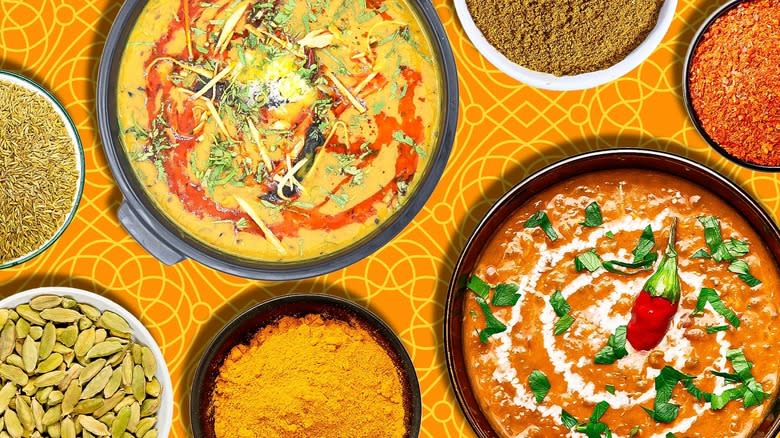
Have you ever looked at a recipe and recoiled at the list of spices involved? Spices are an integral element of Indian fare. Whether it's curries, dry vegetable dishes, lentils, street food, or even desserts, Indian cuisine is brimming with seasonings — many of which you've likely never heard of. It can be intimidating to tackle, especially as a beginner. The art of delicately balancing spices is often talked about with reverence as if it's a near impossibility for a home cook or someone who grew up away from the cuisine to get a handle on — but we're here to assure you: You too can master the art of cooking with spices.
We asked Chef Varun Inamdar, an authority in the Indian culinary world, to share his professional know-how on the subject. As a TV chef, cookbook author, bonafide chocolatier, and Guinness World Record holder, Chef Inamdar has had the privilege of cooking for royal families, actors, and presidents during his 21 years of experience. Undeniably, he knows everything there is to know about spices, and we're honored to bring his exclusive expert tips to you today.
Below, we'll cover everything from how to select spices at the store (yes, it makes a difference), to where to store them, the best way to build layers of flavor that will have your tastebuds dancing, traditional methods to draw incredible amounts of aroma from the spices, and much more. So, if you've been struggling to achieve that je ne sais quoi in your butter chicken or palak paneer, read on.
Read more: Hacks That Will Make Boiling Your Eggs So Much Easier
Buy Seasonings Worth Their Salt
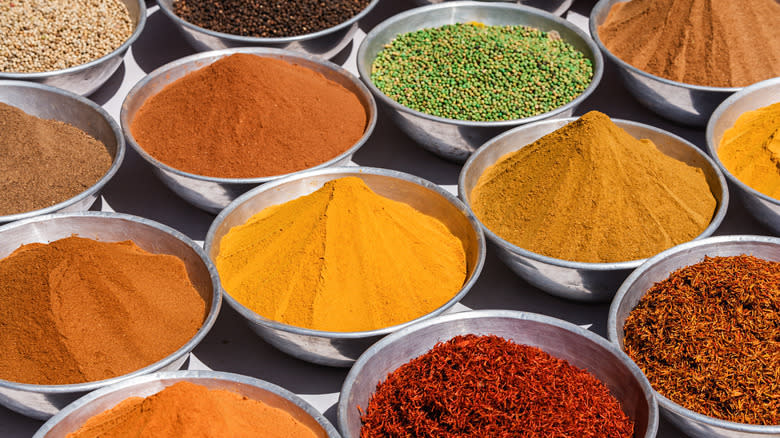
We give so much credence to buying quality for specific items: meats, cheeses, and organic vegetables, for example. But when it comes to spices, most people automatically gravitate toward the first option on the grocery store shelf, not realizing a notable difference in performance. We need to break this habit, says Chef Varun Inamdar. Reflecting further, he recommends we "invest in good quality spices for better flavor."
But where should you head for first-rate spices? Instead of shopping from big-brand stores, turn to your local Asian market. There are three main benefits. First, they usually showcase a more exhaustive variety of spices. Their product turnover is considerably higher, resulting in fresher products on the shelves (and in your baskets), which translates to stronger potency. Plus, a bonus? The staff likely grew up with the cuisine, meaning they can help you find items and give advice effortlessly. Specialty and health-food stores are another excellent shout; they typically stock fair-trade spices with ethical harvesting practices or from small, independent businesses. If neither of these is available nearby, many Asian stores also run online businesses with delivery.
What should you look for? Fresh colors — for example, cardamom is brighter green the fresher it is. Furthermore, Chef Inamdar suggests prioritizing whole spices — though some dishes will require ground spices, too. But generally, whole spices retain their powerful bite, and besides, they're easy to transform into ground spices at home. This process capitalizes on the delicious essential oils spices release immediately after being ground — more on that later.
Use An Ancient Spice Blooming Technique
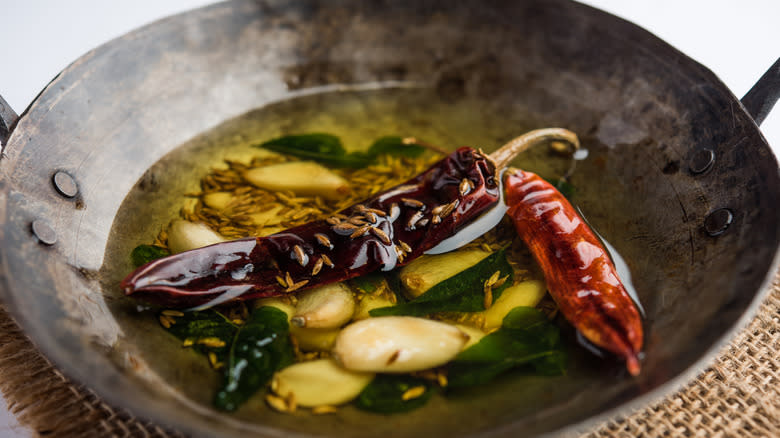
One of the most crucial techniques to level up your spice game is tempering. Chef Varun Inamdar illustrates the process, saying, "Many dishes start by heating oil or ghee and adding whole spices like cumin seeds, mustard seeds, or whole-dried red chilies." The ingredients vary depending on the regional cooking style; cooks commonly add split lentils to the tempering in South India, while citrusy-scented curry leaves are a mainstay in western provinces like Gujarat and Maharashtra.
Appropriately, Chef Inamdar tells us the technique — known in the culinary world as "blooming" spices — goes by many different monikers in India, changing based on language: "phodni in Marathi, phoron in Bengali, thaalithal in Tamil, thalimpu in Telugu, and baghaar in Urdu [are] many such beautiful names for this crackling technique," the chef explains of blooming, which is called tadka in Hindi. Each regional dialect across India (there are thousands) will have a name for this technique — that's how intrinsic it is to the cuisine.
Why does this Indian cooking method add new depths of flavor to spices? Adding spices to hot fat allows the flavors and essential oils to spread throughout the oil — particularly useful when adding tempering at the beginning of a dish. Moreover, chefs routinely finish a dish by pouring over tempered spices. This process adds a pop of brightness and retains the crispy texture of other ingredients like garlic, onions, pulses, nuts, or whole seeds. Sometimes, dishes have tempered spices both at the beginning and end.
Build Flavor By Layering Spices
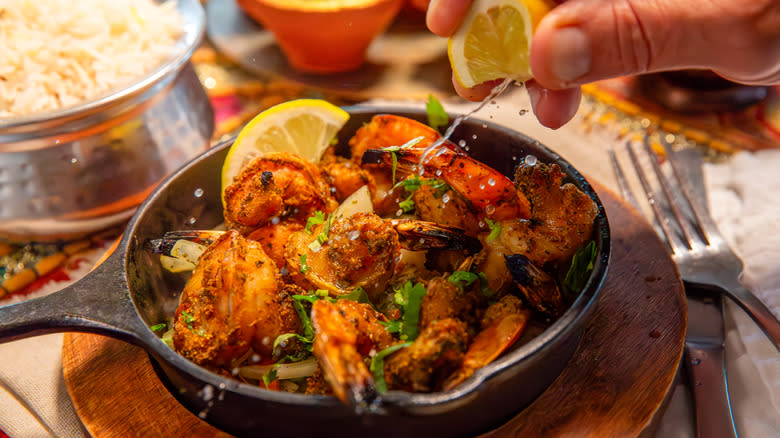
Food lovers worldwide extol Indian dishes for their complexity of character with delicately balanced, layered flavors. But what's the secret? Well, if you've only been adding spices at one stage during cooking, listen closely: For restaurant-quality Indian dishes at home, we should add spices at more than just one stage, as Chef Varun Inamdar explains to us.
First and foremost, you'll want to start with spices. Whole spices (like mustard and cumin seeds) bloomed in oil deliver bursts of concentrated seasoning in every mouthful while also working to flavor the base fat of the dish — usually oil or ghee. Secondly, the phase everyone is probably most acquainted with is adding ground spices. To avoid the spices catching on the pan and becoming bitter, most cooks add them after sweating down onions and garlic (or sometimes after making the tomatoes jammy, since the juices prevent the dry spices from burning). This episode forms the curry base and provides an even wash of flavor across the palate, ranging from pungency, fiery heat, comforting earthiness, or perfume, depending on your selections.
Finally, contrary to popular belief, Chef Inamdar reminds us that delicate spice blends, like garam masala — which he calls "ubiquitous" — shouldn't be fried along with the other ground spices. Instead, use it "towards the end for fragrance." Other aromatic spices — such as nutmeg and cardamom powder — can be used similarly.
Dry-Roast Spices For Boast-Worthy Dishes
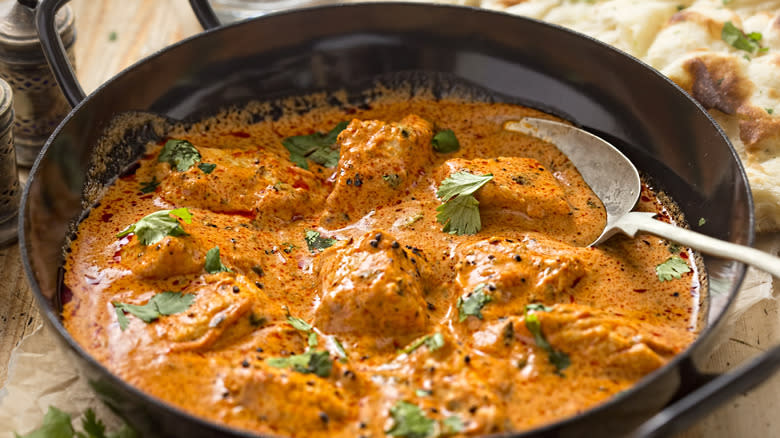
Imagine this: Wafting through the kitchen is the aroma of smokey, citrusy, bold spices. It smells heavenly, and you know this is going to revolutionize your Indian dishes from average to restaurant-level. Most of us have never made the extra effort, but there's no time like the present — celebrity chef Varun Inamdar declares toasting your whole spices to be a game-changer. "Toasting, technically known as broiling, intensifies their flavors and also betters their keeping quality," he says. Win-win.
The process is easy: Grab a heavy-bottomed pan, set the flame to medium, and choose a whole spice. Cumin, coriander, fennel, and mustard seeds are appropriate choices, as are peppercorns, cloves, star anise, nutmeg, and many more. Each spice reacts differently under heat; mustard seeds, for example, "pop," while cumin seeds "crackle," and others can burn in seconds, becoming bitter. Overall, though, the esteemed chef clarifies the process amplifies the core flavors of the spices. However, toasting them further can change the compounds, creating a strikingly dark, full-bodied, and smokey bite — so it's worth experimenting with how far you want to take the technique.
There's no need to add oil, as contrary to tempering/blooming, toasting spices — also called dry-roasting or broiling — requires a dry, hot pan. You can use the spices in your cooking whole, grind them and use them directly in your dishes, or mix them before grinding them to make homemade spice blends (more on that later).
Adjust The Spice Levels To Your Preference

Indian dishes are renowned for tingling heat — but that's not always the case. "Adjust the amount of chili powder or fresh chilies according to your heat preference," Chef Varun Inamdar recommends, whether you have a lower spice tolerance or can't get enough of naga chili peppers.
There's lots of room for savory flavor without heat. For example, Kashmiri chilis are mild, honeyed, and boast a vivid red color — ideal for making eye-catching curry dishes — while Byadgi chilis, one of the most coveted varieties, are earthy and sweet. Alternatively, look to native Indian ingredients; chilis were brought to India long after Indian cuisine was an established powerhouse, and it's possible to add flavor to curry without them. Chef Inamdar points out that pipli (long pepper), a dried fruit with a piney, citrusy, and surprisingly punchy flavor, is a marvelous substitute for chilis, as are the spicy and warm overtones of ginger. Even peppercorns — a seasoning most are familiar with — provide a hint of fruity heat.
For the braver diners, there are hundreds of varieties of chili peppers, each with a different spice level and flavor profile. Indian cooks typically use fresh medium-hot jwala finger chilis with a tart, fruity, and pungent character. Or, why not up the ante with bitter and fiery kanthari chilis or one of the hottest peppers in the world: numbing bhüt jolokia? It's also worth noting using the dynamic ingredients fresh, whole, ground, or even in pickle form changes their potency and impact.
It's Time To Grind (Those Whole Spices)
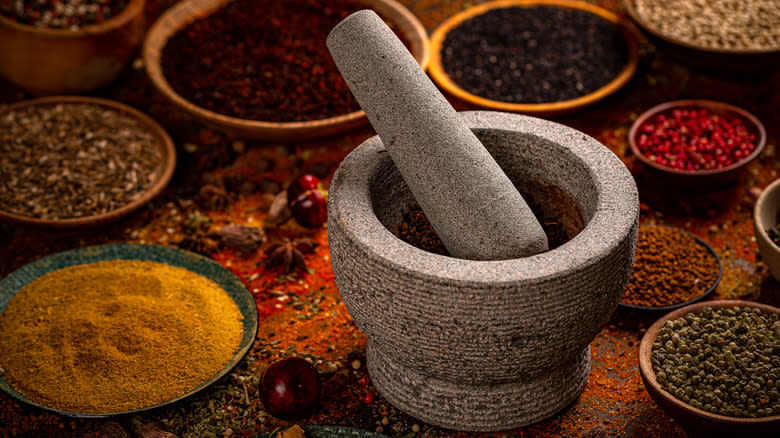
Get out the spice grinder, an old coffee grinder, or an old-fashioned mortar and pestle. Ground spices are essential to any kitchen, especially when you love cooking Indian food. However, you might be surprised to learn celebrity chef Varun Inamdar claims it's better to grind spices at home than purchasing from a store. Why? "Ground spices lose their flavor faster than whole spices," he says, advising home cooks should "consider grinding small batches or buying in smaller quantities." Yes, that's right: Spices don't last forever ... well, not without a momentous drop in caliber.
Ground spices diminish in taste for two reasons: The volatile oils — which produce their complex flavors — evaporate soon after grinding, and exposure to oxygen, even momentarily, causes them to deteriorate further. The solution, as Chef Inamdar states, is to grind only enough whole spices as needed for a specific recipe. This way, you'll capture all the dynamic, sophisticated flavor notes we need for flawless meals.
While it sounds like a hassle, grinding spices at home is remarkably effortless. Start by dry-roasting the spices in a flat pan, then throw them in a spice or coffee grinder and pulverize them to a fine powder. A mortar and pestle works just as well, although it requires more muscle; in keeping with Indian tradition, stone or steel is best. Of course, some spices, like cinnamon, ginger, or turmeric, can't efficiently be crushed at home. It's best to buy these in small batches.
Look Beyond The Standard Spice Blends
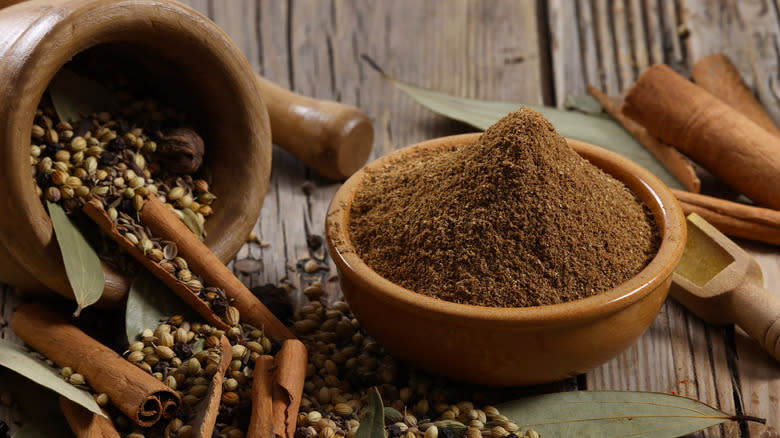
Masalas are the backbone of Indian cuisine. As per Chef Varun Inamdar, "Dry or wet spices, whether ground or whole, are called masalas." Dry masalas include quintessential spice blends like garam masala, but it's worth experimenting to capture the finest authentic flavor. We can categorize spice blends into two groups: regional masalas and dish-based masalas. Regional masalas are best homemade, as they can be tricky to find on store shelves, and include some true hidden gems, such as gunpowder masala (from Tamil Nadu, an extremely spicy mix used as a condiment/topping for dishes), Kolhapuri masala (fiery, punchy, and nutty, native to Kolhapur in Maharashtra), panch poran (aromatic whole spices used in Bengali cuisine), and goda masala (a smokey blend with a distinctive sweet aroma from Maharashtra).
Dish-based masalas are spice blends specifically ground to use in fixed recipes. For example, there is chana masala in chickpea curry, tangy chaat masala for a street food called chaat, achari masala for pickles, and peppery rasam masala for a mouthwatering South Indian lentil broth (called rasam), to name but a few. These are more easily purchased from an Asian store, although you can make them at home, too.
Wet masalas involve grinding spices with other ingredients such as coconut, onion, garlic, ginger, yogurt, or fresh turmeric. It's comparable to a curry paste and can vary depending on region and dish. Some are unique; ver masala, a Kashmiri specialty, is made into patties, hung out to dry, then powdered and used in tantalizingly tasty recipes.
Understand Cooking Techniques And Practice Them

Chef Varun Inamdar's number-one secret for perfecting the use of spices in your Indian dishes? "Understand how different cooking techniques (like tempering, broiling, or finishing with) affect spice flavors and adjust accordingly." And this understanding comes from one thing: practice, practice, and more practice.
We've covered a range of techniques to enhance the flavor of your spices. Now, it's your turn to head into the kitchen and apply each method, paying close attention to how they affect your spices, from intensifying the smokey aromas to subduing bitterness and complementing other components of the dish.
While this exercise is educational, there's no reason it should feel like drudgery. After all, we'll cook some extraordinary foods in the process, which is an excellent reward! Why not try a hearty and homely black lentil soup with tadka to hone your skill at tempering spices? Make a wet masala for our tongue-tinglingly spicy egg curry, toast and grind whole spices for restaurant-style simple palak paneer, or pretend you're an alchemist by mixing up some — frankly magical — dry spice blends. The more Indian dishes you cook, the better you'll understand the underlying science behind gastronomy. And you'd best believe you'll become a better cook for it.
Taste And Adjust The Seasonings As You Go
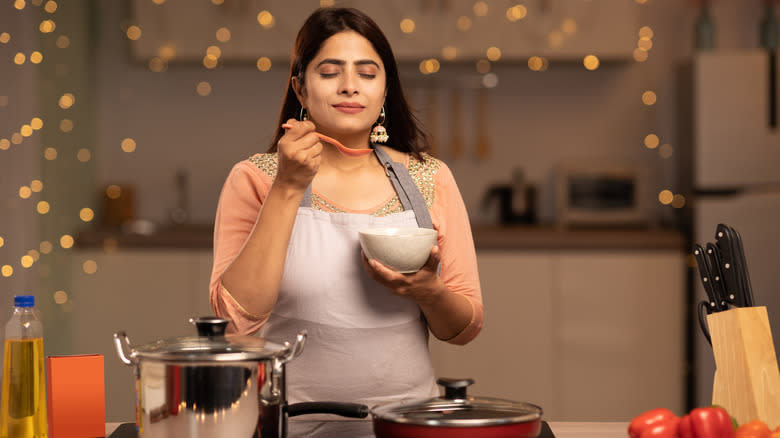
If you've watched any cooking shows — even Chef Varun Inamdar's "The Bombay Chef" — you'll notice a common thread: The best chefs taste their dishes as they go. As Chef Inamdar says, "Adjust spices, salt, and other seasonings to achieve the desired flavor profile." The advice holds across every cuisine but is particularly relevant for Indian food; you want the seasoning balanced, not fighting for dominance.
The benefits are manifold. Foremost, tasting your food regularly throughout cooking allows you to develop an excellent palate. You'll quickly learn to identify spices on a minute level, pinpointing the flavor profile, the brand, and the amounts used. After some experience, you'll notice how combining certain ingredients with spices or using a different cooking technique — like tempering or dry roasting — subtly changes the character of the whole dish.
Beyond this, a surefire way to avert disasters and fix mistakes is by sampling the dish as you cook. For instance, if a dish needs more piquancy, heat, or warmth — or conversely, if it's become too bitter, fiery, or salty — you can correct it before anyone else tastes it. As home cooks, juggling over 10 spices in a dish can be intimidating. But make a habit of tasting your food, and you'll soon have an expert-level palate with the ability to instantly fix or improve almost any meal, not to mention effortlessly cater to the tastes of guests, friends, or family.
Know How To Store Your Spices
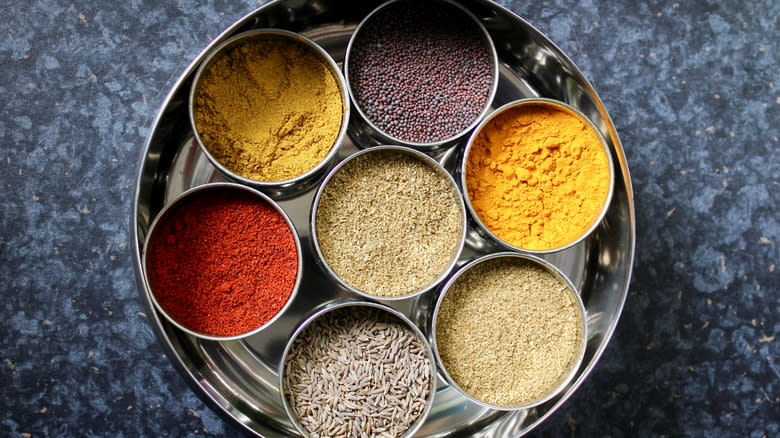
Once you have a selection of quality spices and know how to use them, there's just one more step to ensure your prolonged cooking success. Storing food is usually straightforward, but keeping spices fresh isn't as simple as tying an elastic around the plastic packet or keeping the jars on your counter. Chef Varun Inamdar enlightens us, emphasizing that spices must be stored "in airtight containers away from heat and sunlight to maintain freshness and potency."
If you've bought your spices in plastic bags (standard in Asian grocery stores), decant them immediately into airtight containers like jars or boxes. Then, pop the jars into your pantry, which offers the perfect environment for extending the shelf-life. Alternatively, stack them in a cupboard; make sure it's far from your stovetop, as heat causes spices to dry out, evaporating the essential oils that supply so much aroma and interest to our at-home dishes.
It's worth mentioning that every Indian household has a masala dabba — a round spice box with small bowls filled with spices and covered with a lid. Always accessible and stocked with the most frequently used spices (these vary depending on the cultural cuisine but most frequently include turmeric, coriander, and cumin powder), the masala dabba is an indispensable element of the Indian kitchen. However, this likely isn't a good storage solution unless you cook with spices daily. In Indian households, there's a high turnover; the spices shouldn't be sitting in the masala dabba for long, as the scents meld undesirably.
Read the original article on Tasting Table.


